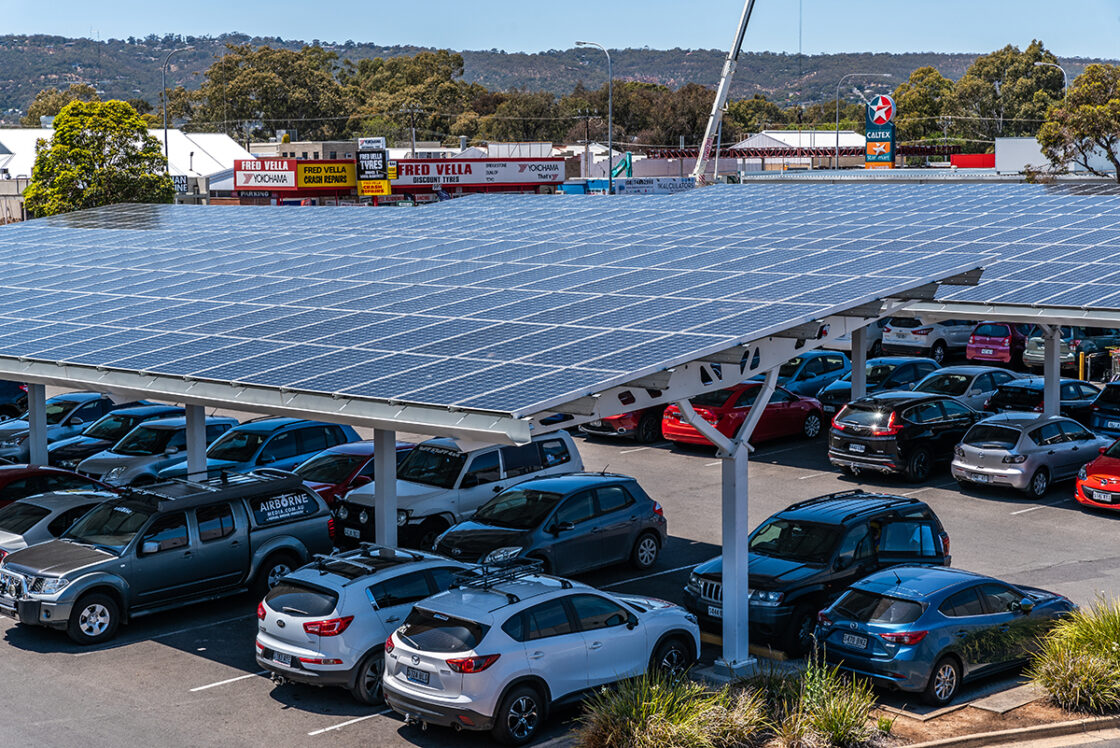Solar canopies have seen a lot of coverage in the press recently, driven by the French government making solar canopies in new car parks mandatory. In a bold move, car parks over 10,000 m2 (very roughly 250 parking spaces), have to comply, and municipal car parks must comply to even stricter rules:
By 1 July 2026 if they are above 10,000 m2 (or smaller, if they are a public service concession) and by 1 July 2028 50% coverage applies to all outdoor car parks with an area greater than 1,500 m2.
This has led to several groups approaching us to ask how they can understand the finances and benefits around solar canopies in car parks, coupled with EV charging.
Types of solar canopy for use in car parks
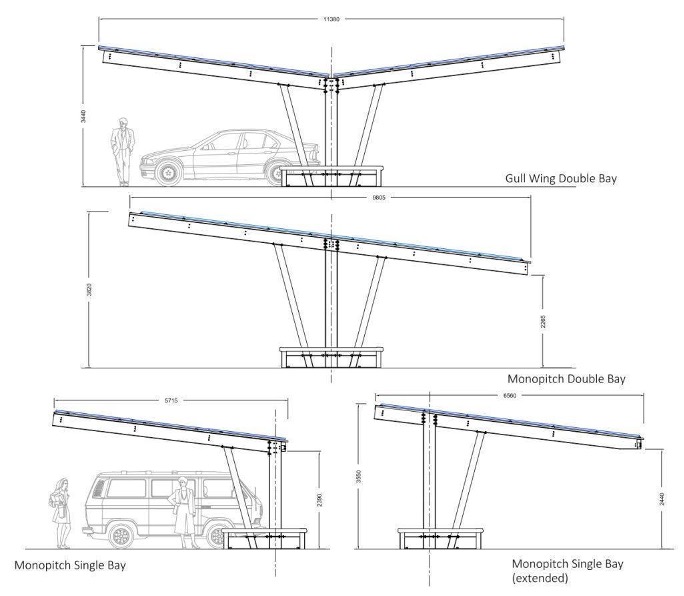
Each of these types are used in different scenarios, depending on how the array is aligned with the cardinal points.
Planning
Until recently, ground-level car park canopies usually required planning permission, but now in England, they usually only require “prior approvals” which are less onerous.
This is the current guidance on the planning portal:
All the following conditions must be observed:
- If above a permeable surface, provision must be made to direct run-off water from the solar canopy to a permeable or porous area or surface within the off-street parking area.
- When no longer needed the equipment should be removed as soon as reasonably practicable.
All the following limits must be met:
- All parts of the development must be four metres in height or less and more than ten metres from the curtilage of a dwellinghouse or block of flats.
- The development cannot be within the curtilage of a dwellinghouse, block of flats or listed building.
- Development must not be on a site designated as a scheduled monument, or on land within the curtilage of a scheduled monument.
- Cannot be used for the display of an advertisement.
- The off-street parking area cannot be in use through permitted development right
Sustainable Urban Drainage System (SUDS) regulations have changed since many car parks were built. The addition of a canopy to the car park might mean that some authorities interpret this as a reason to launch a SUDS study, then treating the run-off from the car park as dirty water (as it mixes with diesel and oil pollution sitting on the surface). This is obviously frustrating, given a canopy does nothing to change the overall quality of the runoff.
One installer made the case to us that managing the runoff from a large mono pitch array spanning double parking spaces was quite challenging, given the volume of water that needs to be channelled in very heavy rain. It is difficult to imagine that installing a canopy without guttering could be considered acceptable if that is the case – no one wants to dodge gallons of falling water falling from above to open the boot of their car during a rainstorm.
Other benefits for solar canopies in car parks
Whilst solar canopies are expensive, there are other benefits that they may bring to a car park. Car parks are rarely considered to be areas of natural beauty: nonetheless, it is possible to make them more attractive.
Reducing light pollution and improving security: Low-level canopy lighting offers the opportunity to remove “football stadium” style flood lighting and reduce light pollution. Canopy lighting can also be motion activated to reduce energy use. Adding lighting becomes an option that may not have existed before, making car parks feel safer and reducing the risk of vandalism.

It is even possible that in some visually sensitive areas that timber or timber clad car ports could be used. It’s worth pointing out that timber car ports may require more vertical posts for support – the example on the right below uses a combination of wood and timber to avoid that issue.
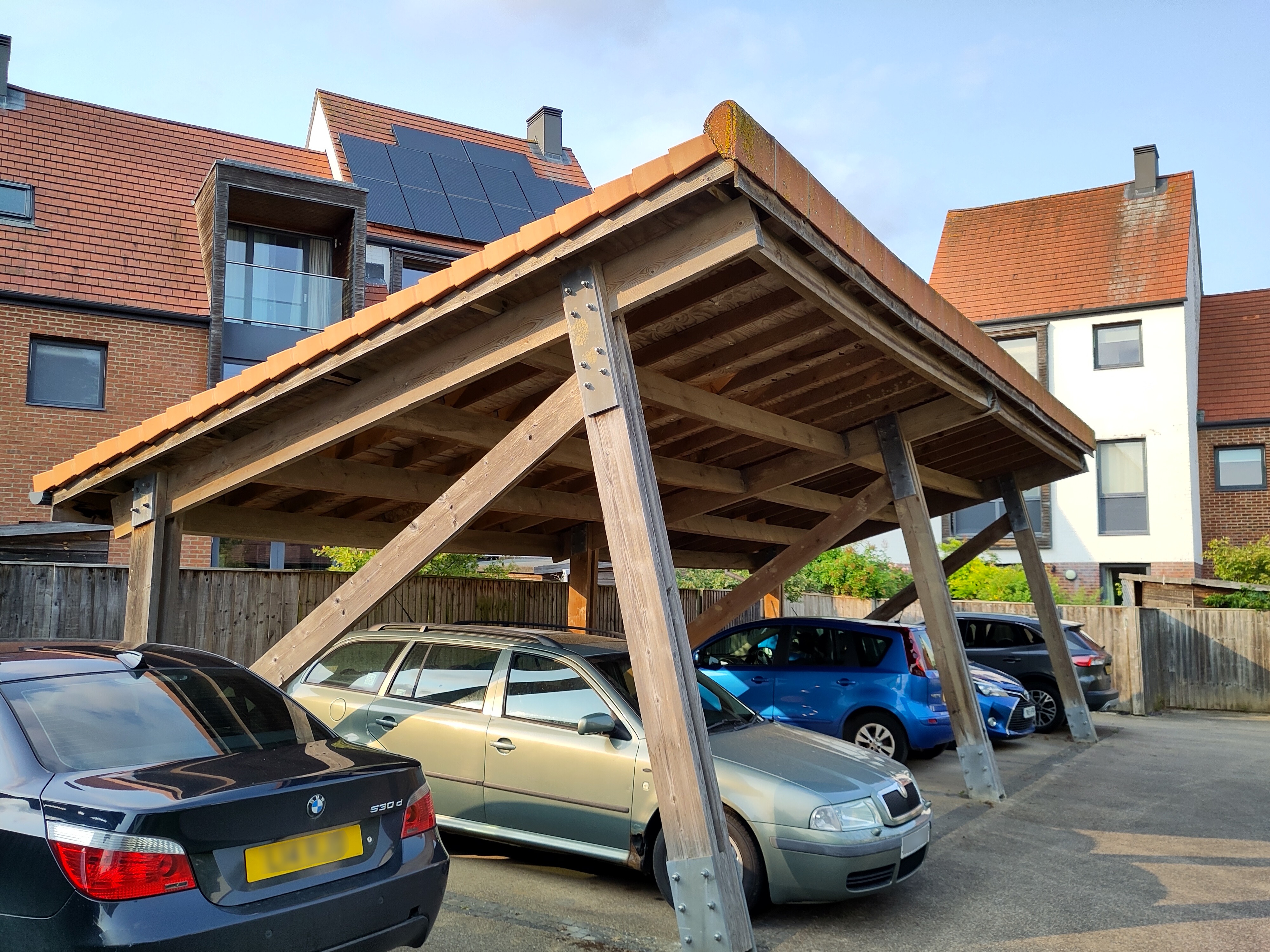
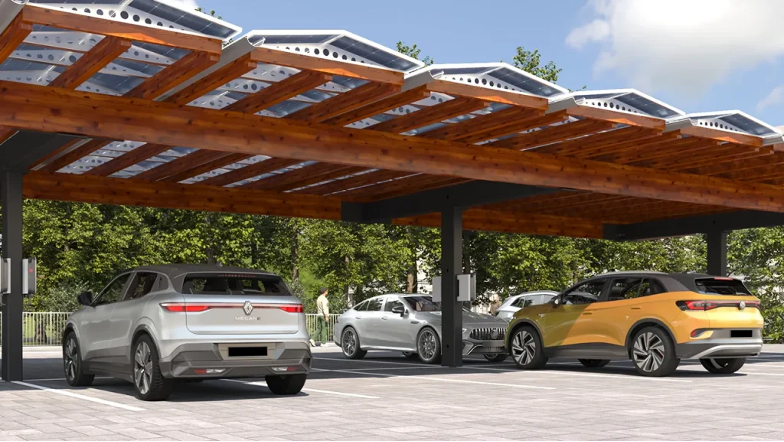
Saving money on civils: Burying cables along “hard dig” surfaces in car parks is typically estimated at around £150 a metre. If the supply cable for the EV chargers could be kept above ground using canopy-mounted EV chargers, for every 10 parking spaces (2.5m per space) it would be possible to save around £4,000 in civils work. Further savings can be achieved by not needing to pay for a pillar to mount the chargers to and using the canopy instead.
An alternative model to the traditional canopy
As an alternative to the traditional canopy, we also considered a vertical “Agri-solar” style array. We believe this solution could be delivered for much lower prices than a canopy, as there is far less steel in the structure, no need to work at height, and no need for lifting equipment. Cleaning and maintenance overheads would also be reduced, and no SUDS study would be required. However, as far as we know, it is a completely untested solution in the UK.
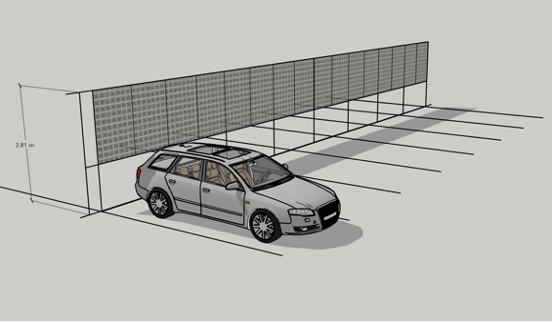
Potential alternative to expensive solar canopies using bifacial panels
When we modelled this option to compare to a traditional canopy with a pitch of 15 degrees facing South we found the vertical bifacial panel arrangement has a reduction of 12% annual yield compared to a conventional South facing array on a canopy. However, we believe it would be significantly cheaper to install: in the region of 50-60% less.
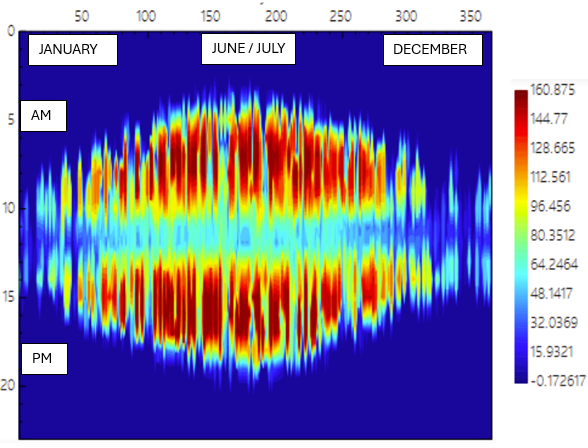
Distribution of energy from bifacial panels over a year
150 pitch standard panels on a conventional canopy, facing South 783 kWh / kWp
Vertical bifacial panels – (Panels face E/W) 695 kWh / KWp
Vertical standard panels – Panels face South 544 kWh / KWp
A canopy will host around 3kW of solar panels per parking space, whereas the vertical fence would be around 1.2kW.
The business case for community owned solar canopies
Conventional ground or roof mounted community owned solar systems can easily be justified in many circumstances, if some simple principles are observed:
- In the absence of feed in tariffs there must always be an “off taker” to purchase electricity
- There are economies of scale for installation costs, but it is more sensible to prioritise high self-consumption of the solar electricity.
- The bigger the system, the more likely you are to get bogged down in development costs and grid connection issues. Larger systems (for example MW scale ground mount) sometimes have to wait in a queue for connection, potentially for years.
If you can find a high user of electricity (50,000 kWh or more), then generating good financial returns (4+% interest on shares) should not be too challenging, assuming more than 60% of the electricity from the solar system is sold to the off taker for a reasonable sum. 10% below market rate is a figure typically used as a starting point for negotiations.
Unfortunately, the cost of solar canopies is extremely high per kW, and this means the normal rules of thumb have to be ignored. Sharenergy conducted a price gathering exercise with some canopy suppliers to ascertain typical costs for canopies that could be installed in the municipal car parks. The outputs of this are shown below.
We asked for pricing for all three of the main types of canopy structure: Single, double mono and “gull wing.” These prices include the installation of the canopy, solar panels, and inverters, but not the cost of connecting the installation to the grid, or EV chargers. We asked the suppliers to allow for provision of CCTV and under-canopy lighting. From this exercise we think it is fair to assume £1,900 – £2,200 per kW (£6,000-£7,000 per parking space) as a reasonable estimate, which is far higher than conventional rooftop or ground mount installations which are typically priced in the range £750 – £1000 / kW. The grid connection costs will be highly variable and would need to be provided for the EV chargers anyway, so they are omitted from the costs in our tables.
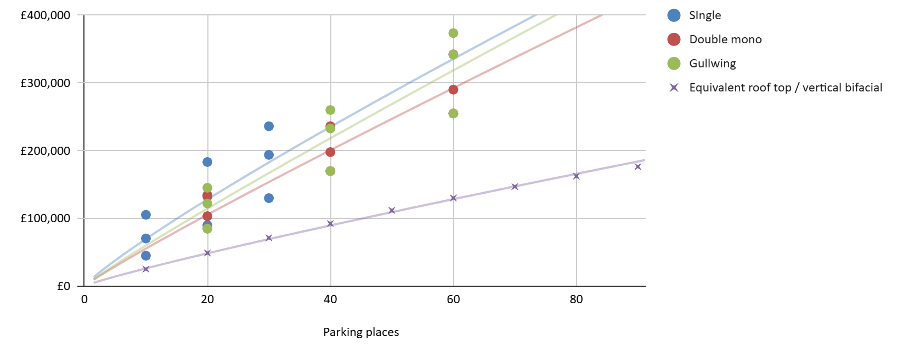
We also obtained prices from a supplier specialising in vertical mounted panels to test our alternative approach. We think it is reasonable to assume an installation cost of around £800 – £1,000 per kW using this method, around half the cost of a cheap canopy and broadly the same as rooftop solar. It would mean a larger number of parking spaces are required per kW, but as you will see in the next section, a smaller system is not necessarily a bad thing.
Self-consumption of the solar electricity
To get close to 100% self-consumption of a modestly sized solar system implies quite a high energy usage for whatever asset is going to use the electricity. It’s very difficult to see how EV chargers alone would ever be able to consume close to 100% of the solar energy of a reasonable size canopy, all the way through the year. For that reason, we believe connecting the array to a building makes more sense.
A typical business open throughout office hours would need to consume around 150,000 kWh of electricity a year to reach a 90% solar self-consumption rate using a 50kW PV system (only 16 parking spaces), as shown below. These rates would improve by adding EV chargers (but are unlikely to reach 100% self consumption). Targeting businesses with electricity use greater than 70,000kWh would be a good starting point. This will likely be large businesses such as supermarkets, sports centres, swimming pools and municipal offices.
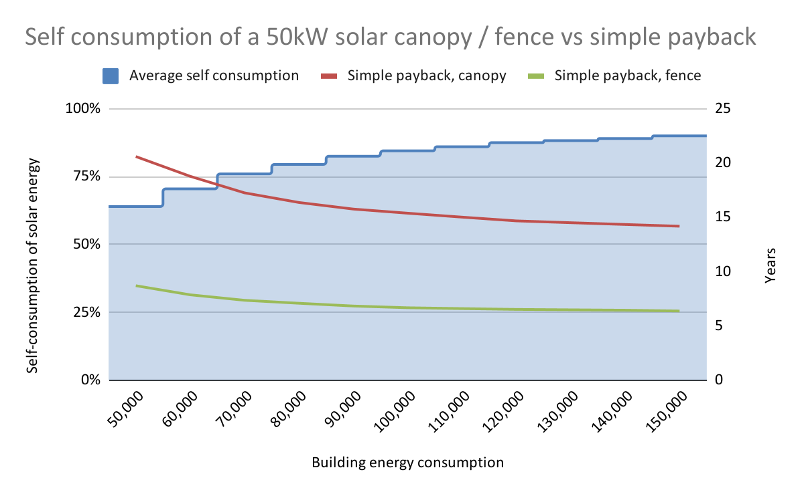
Simple payback does not include cost of connection, returns to investors or community fund payments, and assumes an installation cost of £2,000 per kW for a canopy, and £800 per kW for a solar fence. This chart is only intended to demonstrate the impact of self consumption rates.
Conclusions from our research
Locations for successful solar canopy deployment depend on several “success markers.”
- Reasonably large, unshaded areas of double rows for parking
- Not too many mature trees nearby, which will produce sticky pollen and increase cleaning requirements: they may also need management to prevent shading
- Ideally a nearby building to share a grid connection with – a supermarket, sports centre or other large commercial facility would be ideal
Self-consumption of the solar energy needed to be as high as possible, implying it must be building connected. Unless EV chargers were in constant use it would be impossible to imagine that figures close to 100% self-consumption could ever be realised for canopies not connected to a building, other than in very busy car parks. For this reason, we recommend finding good buildings to connect to, rather than worrying about marginal incomes from EV charging.
From the perspective of the community enterprises wishing to build out these canopies, ideally there would need to be an external source of funding for the solar canopy itself, leaving the community to fund the panels and inverters. It would be worth exploring whether this could come from regeneration or other regional based funding for improvement works by working with a local authority
From the perspective of a local authority there are significant benefits to be realised from solar canopies being co-located with EV chargers,:
- Reducing hard dig and re-instatement costs for buried cables
- A chance to improve the appearance and security of some car parks through low level lighting and CCTV mounted on the canopies.
- An opportunity to generate income from EV charging if they are willing to move away from the more common lease-concession model.
If the local authority wishes to help residents take up EVs who do not have access to off-road parking, it’s important to provide:
- Access to free overnight parking in municipal parking spaces.
- If you want to encourage take up of EVs by people without off road parking living in town centres, cheaper electricity rates than might normally be found at public chargers will be key. There is no financial benefit to owning an EV at typical public charging rates.
There is an inherent value in a grid connection – once you have paid for a grid connection to be installed for EV charging, it really makes sense to exploit it further to connect solar panels, as long as you can do so cost effectively.
Potential sources of funding for the canopy and car parking area
Below is a list of various funding streams that could potentially be accessed by a local authority to help pay for the canopy, lighting and CCTV improvements
Government Programs
- UK Shared Prosperity Fund (UKSPF); focuses on community and place investment, including town centre regeneration and safety improvements.
- Levelling Up Fund – Designed to address regional inequalities through infrastructure investments, including town centre revitalization projects.
- Future High Streets Fund – Specifically targets high street regeneration with funding for transformative projects.
- Towns Fund – Supports towns with long-term economic growth plans, including town centre improvements.
Energy and Sustainability Funding
Community Renewal Fund – Supports pilot programs for local economic recovery and growth.
Safety-Specific Funding
- Safer Streets Fund – Specifically targets crime reduction through interventions like improved street lighting and CCTV.
- Police and Crime Commissioner (PCC) Grants – Many PCCs offer funding for local safety initiatives.
Alternative Funding Models
- National Lottery Funding – Various programs including the Community Fund and Heritage Fund can support town centre improvements.
- Business Improvement Districts (BIDs) – Allows businesses to collectively fund improvements to their local trading environment.
- Section 106 Agreements and Community Infrastructure Levy – Planning obligations that can fund infrastructure improvements from developer contributions.
